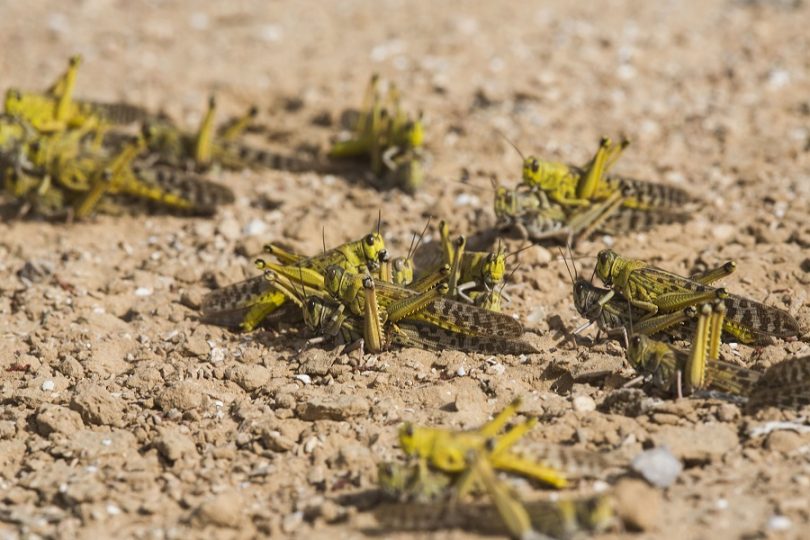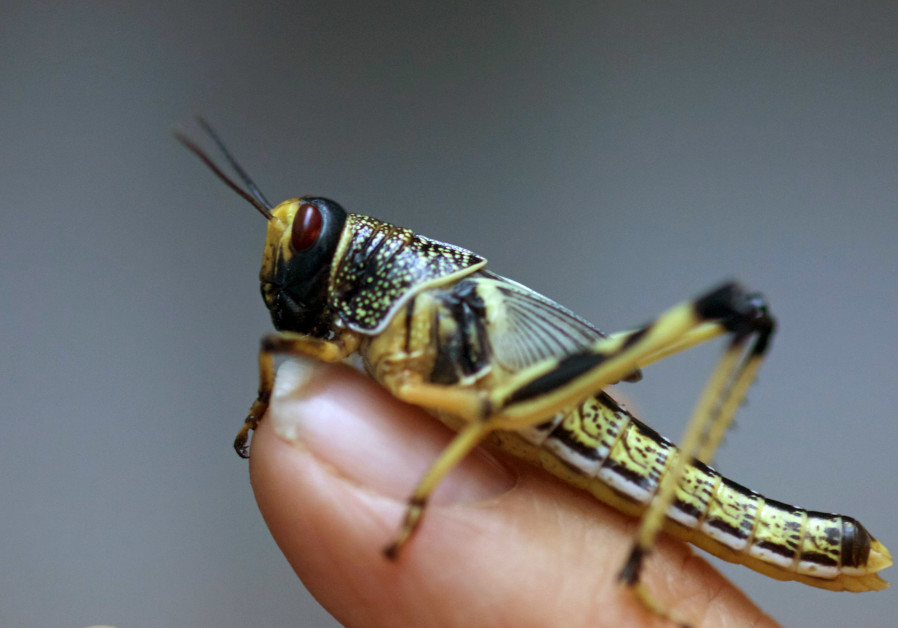The desert locust, known as the world’s most dangerous migratory pest, poses a major threat to food security in the Middel East.
BY JULIA ALTMANN/THE MEDIA LINE
FEBRUARY 21, 2019
A locust is held by Israeli researcher at the Department of Zoology at Tel Aviv University's Faculty of Life Sciences December 22, 2015. Israeli researchers have developed a high-jumping locust lookalike robot that they hope could one day replace humans in military or search-and-rescue operations. P. (photo credit: NIR ELIAS / REUTERS)
The United Nation’s Food and Agriculture Organization (FAO) warned that an infestation of desert locusts in Sudan and Eritrea is rapidly spreading along both sides of the Red Sea towards Egypt and Saudi Arabia.
According to an agency press release, heavy rains triggered two generations of breeding since October, leading to a substantial increase in the locust population.
“The next three months will be critical in bringing the locust situation under control before the summer breeding starts,” FAO’s Senior Locust Forecasting Officer Keith Cressman said.
Earlier this year, the insects evoked biblical times when they showed up at holy sites in Mecca, covering some areas in darkness and sparking a thunderstorm of hail and fire on social media.

Locusts mate in a field in southern Israel in 2013. That swarm caused widespread disturbances in Egypt and Israel. (Ilia Yefimovich/Getty Images)
“These locusts are normally present in low numbers in the desert and don’t cause a big problem. But following a large rainfall they can quickly multiply, eventually forming hopper bands or swarms of adults, composed of billions of individual locusts,” Cressman told The Media Line.According to the FAO, locust swarms can extend outwards several hundred square miles, containing roughly 40-80 million adult locusts in each square mile.What makes these insects so dangerous is their threat to food security, says Cressman.“A desert locust adult can consume its own weight (roughly 2 grams) in food in a day. The added difficulty is they’re normally in the desert, so they’re eating the vegetation there.“Once they get into rain-fed crops on the edge of the desert, grown by poor farmers, they’re eating an entire livelihood, and then they move into the country and affect national food supplies,” he emphasized.
Therefore, a swarm of about 40 million locusts eats the same amount of food in one day as about 35,000 average people. A swarm reaching the size of Paris would eat the same quantity of food in 24 hours as half the population of France, according to the FAO.
“When a locust swarm lands, it can cause crop losses of 80-100 percent,” Dr. Arianna Cease, Director of the Global Locust Initiative at Arizona State University, told The Media Line. “This is particularly devastating for subsistence farmers who depend on their crops to feed their families.”
The current situation has been designated an outbreak, the lowest level of the three classifications for locust invasions—the second being an upsurge and the most severe a plague.
“Once they are adults and can fly, locusts become much more difficult to track, manage, and stop from flying into agricultural areas and subsequently decreasing food security,” Dr. Cease added.
“When locust populations build up, they group together and can travel long distances (60-250 miles daily). This turns them into a continental-level challenge, meaning many countries need to work together to manage outbreaks.”
According to Cressman, each country has a national locust center, and the main strategy adopted to combat them is prevention—consisting of regular monitoring, early warning mechanism and forecasting.
The FAO Commission for Controlling the Desert Locust in the Central Region (CRC), composed of 16 member countries, is convening a meeting in Jordan over the next few days to review the current situation and coordinate efforts to protect crops from “the world’s most dangerous migratory pest.”
For more stories go to themedialine.org

